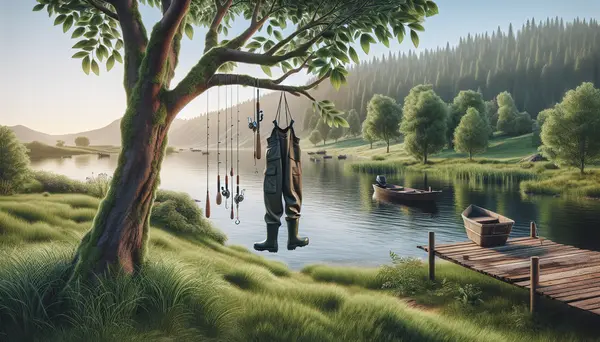Table of Contents:
Introduction to Fishing Waders
Fishing is a pastime that brings joy and relaxation to many. However, staying dry and comfortable while fishing can sometimes be a challenge, especially when you're wading in the water. That's where fishing waders come into play. These essential pieces of gear keep you dry even in wet conditions, enhancing your overall fishing experience.
The Importance of Choosing the Right Fishing Waders
Selecting suitable fishing waders isn't just about comfort; it's also crucial for safety reasons. The right pair will provide protection against cold waters and potential hazards like sharp rocks or underwater creatures. Furthermore, they allow anglers to access deeper waters which might otherwise be unreachable from shore.
Pros and Cons of Different Types of Fishing Waders
| Types of Fishing Waders | Pros | Cons |
|---|---|---|
| Chest Waders | Offers full coverage, allows deep wading. | Can be hot, uncomfortable in warm weather. |
| Hip Waders | Cooler, more comfortable for fishing in shallow water. | Does not provide full coverage, not suitable for deeper wading. |
| Neoprene Waders | Warm, good for cold weather and cold water. | Hot and uncomfortable in warm weather. |
| Nylon Waders | Lightweight, easy to move around in. | May not be as durable as other materials. |
Different Types of Fishing Waders
Fishing waders are available in various styles: hip waders, waist-high wader pants (also known as "wading trousers"), chest high-waist suspenders style ("chesties") and full-body suits with built-in boots ("bootfoot"). Each type has its own advantages depending on the situation:
- Hip waders are perfect for shallow streams or creeks;
- Waist-highs offer more mobility but less coverage than chest highs;
- Chest highs give maximum coverage making them ideal for deep rivers or lakes;
- A bootfoot suit provides all-over protection - great if you plan on spending long hours standing in water.
Main Features To Consider When Buying Fishing Waders
To choose the best fishing wader, consider these key features:
- Type of Material: Common materials include neoprene (warmest), breathable fabric (most comfortable) and PVC or rubber (cheapest). Each has its pros and cons, so choose based on your specific needs.
- Size: Waders should fit well but not too tightly. You need room for layers underneath during colder months.
- Durability: Look for reinforced knees and seams to ensure the wader can withstand wear-and-tear from fishing activities.
The Role of Boots in Fishing Waders
A crucial part of any fishing wader is the boot. Some come with attached boots while others require separate ones. When choosing a pair, consider factors like sole type (felt vs rubber), insulation level, ankle support, and whether they're cleated or non-cleated - each factor affects traction on different surfaces.
Caring For Your Fishing Waders
To extend their lifespan, it's essential to care properly for your fishing waders. Rinse them off after use to remove dirt or saltwater which could degrade the material over time. Dry them thoroughly before storing away; moisture can lead to mildew growth that weakens the fabric. Regularly check for leaks or tears and repair promptly if found.
Finding The Best Brands Of Fishing Waders
You'll find many brands offering quality fishing waders,. Renowned names include Simms, Orvis, Patagonia among others known for durability & comfort features such as padded knee areas or adjustable straps/belts ensuring a perfect fit every time you go out angling!
In Conclusion: Choosing The Right Fishing Wader Matters!
Selecting suitable fishing waders isn't just about staying dry—it also enhances your fishing experience by allowing you to reach deeper waters and protecting against potential hazards. By considering factors like material type, size, durability, boot features and brand reputation when choosing a pair of waders, you can ensure that your next fishing trip will be comfortable and enjoyable.
Frequently Asked Questions about Choosing the Right Fishing Waders
What are the types of fishing waders?
There are three main types of fishing waders: hip waders, waist-high waders, and chest waders. The right choice depends on the depth of the water and the type of fishing.
What materials are fishing waders made of?
Most fishing waders are made of neoprene, rubber, or breathable materials like Gore-Tex. Neoprene and rubber waders are waterproof and warm, while breathable waders are lightweight and comfortable.
How do I choose the right size of fishing waders?
Fishing waders should fit comfortably over your clothing. Consider your shoe size, inseam, and girth measurements when choosing a size. Always consult the manufacturer's size chart.
How do I maintain and care for my fishing waders?
After use, rinse your waders with fresh water and allow them to air dry out of direct sunlight. Check for and repair any leaks promptly to prolong the life of your waders.
Are expensive fishing waders worth the investment?
Better quality materials and construction can make more expensive waders worth the investment. They can be more durable, comfortable, and possess advanced features like reinforced knees or gravel guards.







